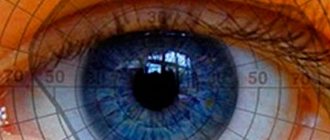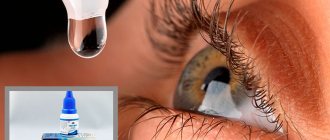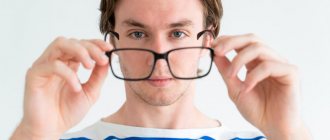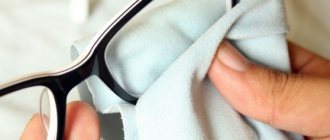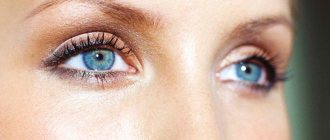Farsightedness (hyperopia) is a refractive error in which light rays are refracted in such a way that they are focused behind the retina. This prevents you from seeing a clear image.
When a person is first diagnosed with farsightedness, he asks the question: is farsightedness a plus or a minus?
Like any refractive error, hypermetropia reduces visual acuity and causes a number of asthenopic complaints: a burning sensation in the eyes, fatigue, headaches. This means an inevitable decline in quality of life. It is difficult for a person to read small text on product packaging, it is impossible to work with small objects, embroider, read, etc. For farsighted people, all of the above activities become a serious problem.
What do experts mean when they say that farsightedness is a plus? We are talking about the degree of farsightedness:
- weak – up to +3 D,
- average – from +3 to +6 D,
- high – from +6 D.
Hypermetropia is a refractive error that requires correction with “plus” lenses. In a farsighted person, the image is focused behind the retina. “Plus lenses” change the refraction of rays so that they are focused clearly on the retina. The curvature of the lens is determined by the degree of hypermetropia.
How is the anomaly corrected?
Farsightedness is a refractive error. You can solve the problem by wearing glasses with “plus” diopters. Such optical devices refract light rays in such a way that they are focused not behind the retina, but on it.
The ophthalmologist selects glasses with “plus” diopters for the patient after a computer examination. It is prohibited to choose lenses yourself. Such actions can lead to a sharp decrease in vision and discomfort while wearing these optical devices. Correction of farsightedness is carried out taking into account the following factors:
- degree of development of pathology;
- patient's age;
- accompanying illnesses;
- patient's profession
- his wishes.
In some cases, specialists at our clinic resort to hardware-computer vision restoration.
In special cases, surgical treatment of hypermetropia is performed. It is necessary for patients who cannot wear glasses or contacts, or they do not provide a positive effect. The operation is characterized by its advantages:
- the ability to refuse to wear contact lenses and glasses;
- high performance;
- noticeable improvements soon after surgery.
Surgery can improve the quality of life of patients.
Methods of treatment and correction
Based on the above facts, we can conclude that this disease is a disadvantage and therefore requires immediate treatment. This is especially true for medium (3.26-6 diopters) and high (over six diopters) degrees of the disease.
Weak (up to three diopters) and sometimes moderate forms of myopia are eliminated with the help of optical correction for distance using weak (one or two diopters) lenses for working at close distances.
To correct myopia, minus (negative) lenses . In this case, negative lenses are placed in front of the patient’s eye, then they look at the result. They start with weak lenses; if vision does not improve, then use stronger glasses. As a result, maximum vision restoration is achieved using a specific minus lens.
Depending on the degree of myopia, a person may experience a temporary or permanent need for glasses. A modern method of treating this disease is laser correction. However, it allows you to compensate for myopia.
What is pterygium, causes, modern methods of treatment.
You can find out what treatment is recommended for blepharoconjunctivitis on this page.
"Short Arm Disease"
Farsightedness caused by age-related changes in the lens of the eye is known as presbyopia, or short-arm disease. The disorder received this name because usually a person with this problem needs to move it a great distance to read the text.
Presbyopia can sometimes be combined not only with farsightedness, but also with myopia, which must be taken into account by the ophthalmologist when choosing glasses. After the examination, he can understand whether positive or negative diopters are needed to correct vision. For patients suffering from presbyopia, bi- or multifocal glasses are selected. Their peculiarity is that they provide good vision at both close and long distances.
Causes of the disease
Myopia most often develops during school years. Moreover, heredity plays a significant role here. Among the factors contributing to the development of this disease are prolonged work at close distances under poor hygienic conditions or improper lighting. Given the massive distribution of computers, this problem is becoming serious.
If measures are not taken to eliminate myopia in a timely manner, this condition can lead to irreversible changes and significant loss of visual function. This in turn will partially or completely limit your ability to work.
Weakening of the eye muscles also contributes to the development of myopia. To solve this problem, special sets of physical exercises have been developed that can be used for both therapeutic and preventive purposes.
As a result, the progression of this disease is often slowed down or stopped. Previously, it was recommended to limit physical activity for people suffering from myopia. However, moderate exercise with a rational rest and sleep regime is currently recommended.
At a young age, myopia can be caused by a spasm of accommodation, changes in the shape of the cornea (keratoconus), displacement due to lens injuries (luxation, subluxation), and sclerosis of the lens. The latter pathological condition leads to the development of myopia in old age.
Correcting high myopia is difficult and requires an individual approach to the selection of lenses for distance and near. With the development of senile myopia due to sclerosis of the lens, it is replaced or implanted with phakic lenses.
Prevention of farsightedness
A mandatory preventative measure for the development of hypermetropia should be regular visits to the ophthalmologist’s office and compliance with his recommendations. If there are no vision problems, it is enough to undergo an examination once a year. The following prevention is recommended:
- When watching TV, reading or working at the computer, you need to regularly do eye exercises.
- The diet should be enriched with fresh vegetables, fruits, and herbs. It is important to exclude the consumption of fast food, salty foods, and alcoholic beverages.
- If you notice any vision problems, visit an ophthalmologist.
Farsightedness can be easily corrected with timely treatment.
Is myopia a minus or a plus?
Ophthalmologists call myopia a vision defect in which a person does not clearly recognize distant objects.
Ophthalmologists call myopia a vision defect in which a person does not clearly recognize distant objects. Another, most popular name for this disease is myopia, i.e. objects located nearby are clearly visible. A patient suffering from myopia can work with small objects located nearby, read and write texts, and do embroidery without any difficulties, but problems arise with distant objects.
People with myopia must remember that to correct the manifestations of the disease they need special optics to improve vision with a minus sign, since myopia is characterized by a minus indicator. To do this, you need to go to a medical clinic and see an ophthalmologist who will help you choose the right negative lenses for glasses. For patients suffering from farsightedness, everything is accurate; on the contrary, visibility in the distance is good, but near vision difficulties arise. In case of farsightedness, optical instruments with a plus sign will help improve vision, and thus farsightedness is determined by a plus value.
How to easily test your vision?
Anyone can easily test their own vision. To do this, you need to look at objects that you previously saw very well from a distance of 5 meters. Blurredness or unclearness of the image, which was previously perceived without comment at such a distance, is a signal to contact an ophthalmologist and have your vision checked by a specialist.
Myopia can be congenital or acquired, which is classified according to the severity of the disease and measured in diopters. Doctors distinguish 3 degrees of development of myopia, or loss of vision:
- Weak degree - up to 3 diopters.
- Average degree from 3 to 6.5 diopters.
- High – over 6.5 diopters.
Symptoms and diagnosis of myopia in children
If your child has trouble seeing in the distance what he previously saw very well, if he frowns, squints, complains of eye fatigue, if you begin to notice that he comes close to the TV or the blackboard at school, then these are signs of the development of myopia.
When contacting your doctor, an experienced ophthalmologist will first of all carry out such mandatory diagnostic procedures as:
- visual acuity test;
- skiascopy;
- cycloplegia;
- refractometry.
And based on the results of the research, specific recommendations for treating the disease will be given.
Myopia treatment in Makhachkala
In most cases, negative vision in children is treatable. Treatment methods for myopia in childhood include the following areas:
- Medicinal - vitamins A and E, containing blueberries, taurine, lutein.
- Treatment in the children's vision care office (COZD). An ophthalmologist selects the necessary treatment for each child.
- Optical correction – glasses correction, wearing contact lenses.
- Surgical vision correction – strengthening of the scleral tissue of the eye (scleroplasty), laser correction.
Disease prevention
To prevent the development of myopathy in children, experts strongly recommend following the following simple rules:
- Compliance with the work and rest schedule.
- Annual vision examination at school and clinic.
- General strengthening of the body, physical exercise, preferably in the fresh air.
- Restrictions on working with gadgets (smartphone, telephone, computer).
- Balanced diet.
Do not allow your child’s myopia to progress. Show it to your doctor in a timely manner to receive the necessary course of therapy. After all, myopia is not only a minus in diopters, it is also a minus in the quality of life of the baby.
➕ for a plus
Krestall/Courier
“Of course, this is tough. But these are modern realities. I will say for myself that sometimes I play with a plus. But if I play, it’s at club performances, at night, and when no one [cares] whether you’re alive or not. If we talk about solo concerts, then, of course, it’s lively, but with backings. This is when the bangers (militants. - Approx. IMI)
) you leave out the chorus parts or certain backing parts. I perform alone, so I don’t always have enough breathing space to connect certain parts of the verse. But I’ll tell you straight: it’s better to mess up live than to perform perfectly without a plus.
Sometimes I am so inadequate that I choose online with a DJ that it is better to leave certain songs under plus full. This topic is generally controversial. Some people generally look better with a plus, while others tear you apart with their charisma and voice.
Why did the mass audience get used to this? Let's go back 15 years, it would have been quite strange for that time to perform with a plus. And all over the world. But if we talk about rap in 2019, it is the simplest, multicultural, flexible and limitless genre. The amount of music released into the market every day is enormous. Therefore, the listener’s demands are lower, so he is ready to put up with the fact that at concerts artists sometimes [sing] to a soundtrack.”
➕ for a plus
Flash
“My attitude towards artists who sing to plus is normal. At my solo concerts there is always 50% live sound: I perform the verses myself, and leave a backing for the choruses to preserve the fat. If it’s a lyrical song, I sing it myself. At festivals - always a plus, backing and live versions ( recorded backing vocals. - Approx.
.
IMI)
, otherwise the performance fat is lost.
Now Mouzon is digital: computer, synths, drum machine, 808s. When you are at a concert or festival, people lack fat and muscle if the track is played only by voice. To turn people on, you need to jump, move, perform a show. And by the third track - any artist won’t let you lie - you simply won’t have any breathing left: you’ll sound either terrible or uneven, and there’s no point in that. As part of a festival, where there are 5-6 thousand people and you want everyone to rock and have enough fat for everyone, you need to perform to backing, prepared live versions, plus, and so on.
It’s smarter to perform live slow tracks, lyrical songs, to which they turn on the lights of the phones, to which you do not move. You stand with the counter and sing so that your breathing is not impaired. Everything is different at the festival.”
